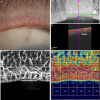Quantitative Assessment of Lid Margin Vascularity Using Swept-Source Optical Coherence Tomography Angiography
- PMID: 38874976
- PMCID: PMC11182367
- DOI: 10.1167/tvst.13.6.6
Quantitative Assessment of Lid Margin Vascularity Using Swept-Source Optical Coherence Tomography Angiography
Abstract
Purpose: To evaluate the ability of swept-source optical coherence tomography angiography (SS-OCTA) to assess lid margin vascularity.
Methods: This prospective, cross-sectional trial enrolled 125 participants, including 15 control subjects and 110 meibomian gland dysfunction (MGD) patients. Lid margin blood flow density (LMBFD) was obtained using SS-OCTA. LMBFD was assessed for repeatability in 54 of 125 participants and for reproducibility in 23 of 125 participants. The efficacy of LMBFD was validated in the 125 participants, who were divided into mild (n = 46), moderate (n = 42), and severe groups (n = 37) according to the lid margin vascularity severity shown in the slit-lamp photographs. Correlations between LMBFD and MG-related parameters, such as ocular surface disease index (OSDI), fluorescein tear break-up time (FTBUT), cornea fluorescein staining (CFS), lid margin score (LMS), and meibomian gland expressibility (ME), were analyzed in all 125 participants.
Results: Repeatability and reproducibility coefficients were satisfactorily high in the scan mode with a scan area of 6 mm × 6 mm (intraclass correlation coefficient [ICC] repeatability = 0.905; ICC reproducibility = 0.986) and a scan area of 9 mm × 9 mm (ICC repeatability = 0.888; ICC reproducibility = 0.988). The LMBFD gradually increased in the mild, moderate, and severe groups (P < 0.001). LMBFD was significant correlated with OSDI (r = 0.290, P = 0.001), FTBUT (r = -0.195, P = 0.030), CFS (r = 0.352, P < 0.001), ME (r = 0.191, P = 0.033), and LMS (r = 0.370, P < 0.001).
Conclusions: LMBFD may be a noninvasive, repeatable, reproducible, and efficient index for the quantitative evaluation of eyelid margin vascularity in the future.
Translational relevance: We demonstrated that SS-OCTA has the potential to evaluate the eyelid margin vascularity in MGD patients and guide future treatment strategies in clinics.
Conflict of interest statement
Disclosure:
Figures




Similar articles
-
Repeatability and reproducibility of a new fully automatic measurement optical low coherence reflectometry biometer and agreement with swept-source optical coherence tomography-based biometer.Br J Ophthalmol. 2024 May 21;108(5):673-678. doi: 10.1136/bjo-2023-323268. Br J Ophthalmol. 2024. PMID: 37142332
-
Relationship between type 2 diabetes mellitus and changes of the lid margin, meibomian gland and tear film in dry eye patients: a cross-sectional study.Int Ophthalmol. 2025 Jun 24;45(1):261. doi: 10.1007/s10792-025-03636-w. Int Ophthalmol. 2025. PMID: 40553413 Free PMC article.
-
Comparison of non-invasive and fluorescein tear film break-up time in a 65-year-old Norwegian population: a cross-sectional study.BMJ Open. 2025 Apr 10;15(4):e090305. doi: 10.1136/bmjopen-2024-090305. BMJ Open. 2025. PMID: 40216423 Free PMC article.
-
Interventions for chronic blepharitis.Cochrane Database Syst Rev. 2012 May 16;2012(5):CD005556. doi: 10.1002/14651858.CD005556.pub2. Cochrane Database Syst Rev. 2012. PMID: 22592706 Free PMC article.
-
Topical treatments for blepharokeratoconjunctivitis in children.Cochrane Database Syst Rev. 2017 Feb 7;2(2):CD011965. doi: 10.1002/14651858.CD011965.pub2. Cochrane Database Syst Rev. 2017. PMID: 28170093 Free PMC article.
References
-
- Bron AJ, de Paiva CS, Chauhan SK, et al. .. TFOS DEWS II pathophysiology report. Ocul Surf. 2017; 15(3): 438–510. - PubMed
-
- Arita R, Fukuoka S, Morishige N.. Therapeutic efficacy of intense pulsed light in patients with refractory meibomian gland dysfunction. Ocul Surf. 2019; 17(1): 104–110. - PubMed
Publication types
MeSH terms
LinkOut - more resources
Full Text Sources

